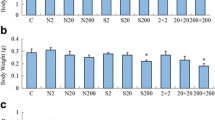Abstract
The effects of chronic dietary selenomethionine (SeMet) exposure on the visual system of adult zebrafish and their progeny were investigated. Adult zebrafish were exposed to measured concentrations of 1.1 (control) and 10.3 µg Se/g dry mass as SeMet for 57 days, then encouraged to breed. Progeny were reared to swim-up and differences in mortality, eye size and visual behaviour were determined. Adult vision was also investigated using behavioural assays. Adults fed the SeMet-spiked diet exhibited significantly fewer positive reactions in the escape response assay when compared to controls. Larvae from adults fed elevated SeMet had smaller eyes and a lower proportion of positive responses in phototaxis, oculomotor and optokinetic response assays compared to controls. These results demonstrate that environmentally relevant elevated dietary SeMet exposure can affect the visual system of both exposed adult zebrafish and their progeny, which could affect fitness and survivability.
Similar content being viewed by others
References
Avanesov A, Malicki J (2010) Analysis of the retina in the zebrafish model. Methods Cell Biol 100:153–204
Behne D, Kyriakopoulos A, Scheid S, Gessner H (1991) Effects of chemical form and dosage on the incorporation of selenium into tissue proteins in rats. J Nutr 121:806–814
Brockerhoff SE, Hurley JB, Janssen-Bienhold U et al (1995) A behavioral screen for isolating zebrafish mutants with visual system defects. Proc Natl Acad Sci USA 92:10545–10549
Chhetri J, Jacobson G, Gueven N (2014) Zebrafish-on the move towards ophthalmological research. Eye 28:367–380
Choudhury S, Thomas JK, Sylvain NJ et al (2015) Selenium preferentially accumulates in the eye lens following embryonic exposure: a confocal x-ray fluorescence imaging study. Environ Sci Technol 49:2255–2261
Fan TW, Teh SJ, Hinton DE, Higashi RM (2002) Selenium biotransformations into proteinaceous forms by food web organisms of selenium-laden drainage waters in California. Aquat Toxicol 57:65–84
Fleisch VC, Neuhauss SC (2006) Visual behavior in zebrafish. Zebrafish 3:191–201
Gahtan E, Tanger P, Baier H (2005) Visual prey capture in larval zebrafish is controlled by identified reticulospinal neurons downstream of the tectum. J Neurosci 25:9294–9303
Götz T, Janik VM (2011) Repeated elicitation of the acoustic startle reflex leads to sensitisation in subsequent avoidance behaviour and induces fear conditioning. BMC Neurosci 12:1–13
Huang L, Zuo Z, Zhang Y et al (2014) Use of toxicogenomics to predict the potential toxic effect of benzo(a)pyrene on zebrafish embryos: ocular developmental toxicity. Chemosphere 108:55–61
Janz DM, DeForest DK, Brooks ML et al (2010) Selenium toxicity to aquatic organisms. In: Chapman MP, Adams WJ, Brooks ML et al (eds) Ecological assessment of selenium in the aquatic environment. CRC Press, Boca Raton, pp 141–231
Janz DM, Liber K, Pickering IJ et al (2014) Integrative assessment of selenium speciation, biogeochemistry, and distribution in a northern coldwater ecosystem. Integr Environ Assess Manag 10:543–554
Kimmel CB, Patterson J, Kimmel RO (1974) The development and behavioral characteristics of the startle response in the zebra fish. Dev Psychobiol 7:47–60
Lemly AD (1997) A teratogenic deformity index for evaluating impacts of selenium on fish population. Ecotoxicol Environ Saf 37:259–266
Lemly AD (2004) Aquatic selenium pollution is a global environmental safety issue. Ecotoxicol Environ Saf 59:44–56
Li L, Dowling JE (1997) A dominant form of inherited retinal degeneration caused by a non-photoreceptor cell-specific mutation. Proc Natl Acad Sci USA 94:11645–11650
Neuhauss SC (2003) Behavioral genetic approaches to visual system development and function in zebrafish. J Neurobiol 54:148–160
Orger MB, Gahtan E, Muto A, Page-McCaw P, Smear MC, Baier H (2004) Behavioral screening assays in zebrafish. Methods Cell Biol 77:53–68
Schneider CA, Rasband WS, Eliceiri KW (2012) NIH image to ImageJ: 25 years of image analysis. Nat Methods 9:671–675
Thomas JK, Janz DM (2011) Dietary selenomethionine exposure in adult zebrafish alters swimming performance, energetics and the physiological stress response. Aquat Toxicol 102:79–86
Thomas JK, Janz DM (2014) In ovo exposure to selenomethionine via maternal transfer increases developmental toxicities and impairs swim performance in F1 generation zebrafish (Danio rerio). Aquat Toxicol 152:20–29
Thomas JK, Janz DM (2015) Developmental and persistent toxicities of maternally deposited selenomethionine in zebrafish (Danio rerio). Environ Sci Technol 49:10182–10189
Zou SQ, Yin W, Zhang MJ, Hu CR, Huang YB, Hu B (2010) Using the optokinetic response to study visual function of zebrafish. JoVE 36:e1742
Acknowledgments
This research was supported by a Natural Sciences and Engineering Research Council of Canada (NSERC) Discovery Grant (RGPIN 288163) to D.M.J. The authors gratefully acknowledge the technical assistance of Iris Chen.
Author information
Authors and Affiliations
Corresponding author
Rights and permissions
About this article
Cite this article
Raine, J.C., Lallemand, L., Pettem, C.M. et al. Effects of Chronic Dietary Selenomethionine Exposure on the Visual System of Adult and F1 Generation Zebrafish (Danio rerio). Bull Environ Contam Toxicol 97, 331–336 (2016). https://doi.org/10.1007/s00128-016-1849-9
Received:
Accepted:
Published:
Issue Date:
DOI: https://doi.org/10.1007/s00128-016-1849-9




